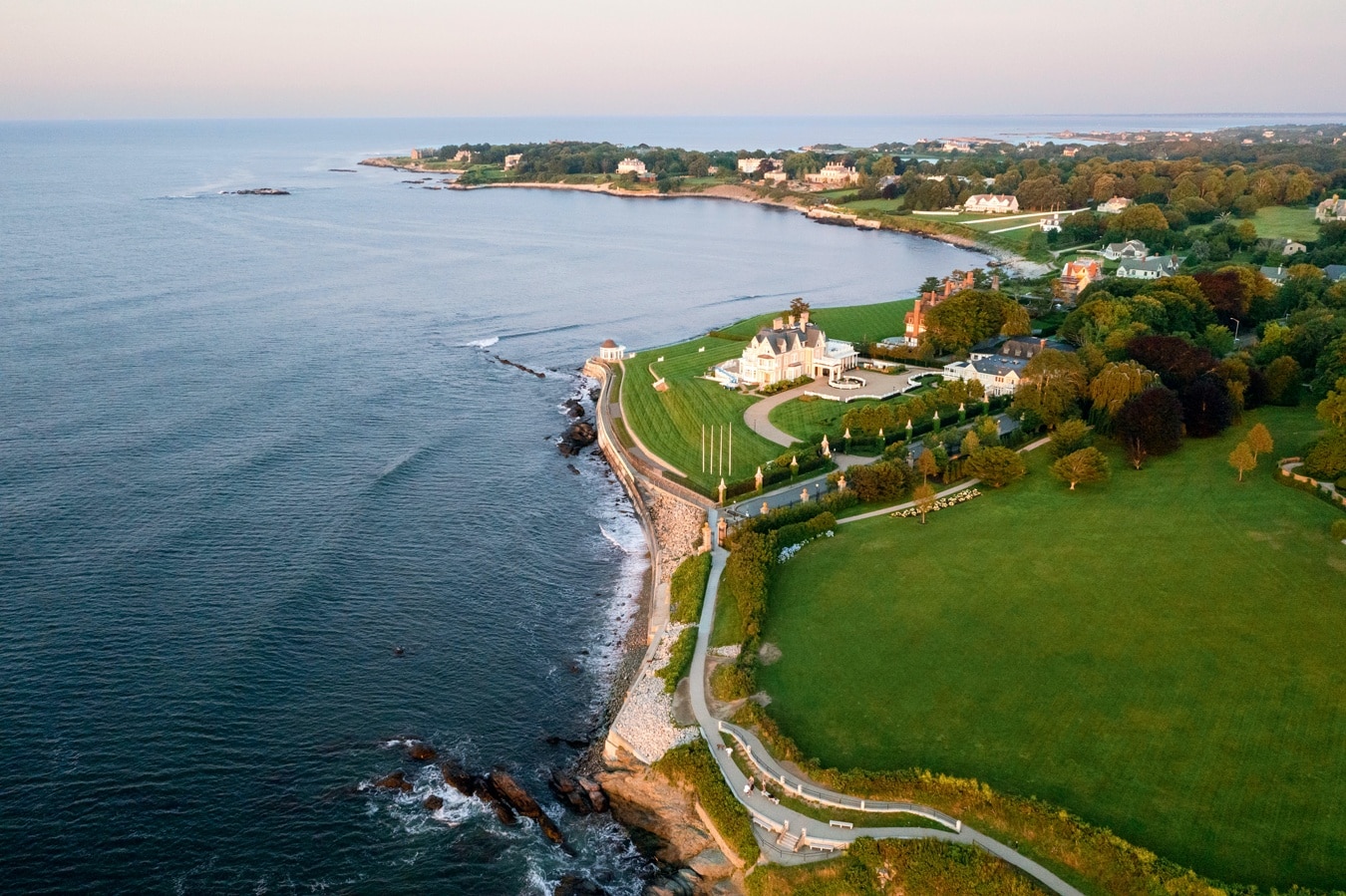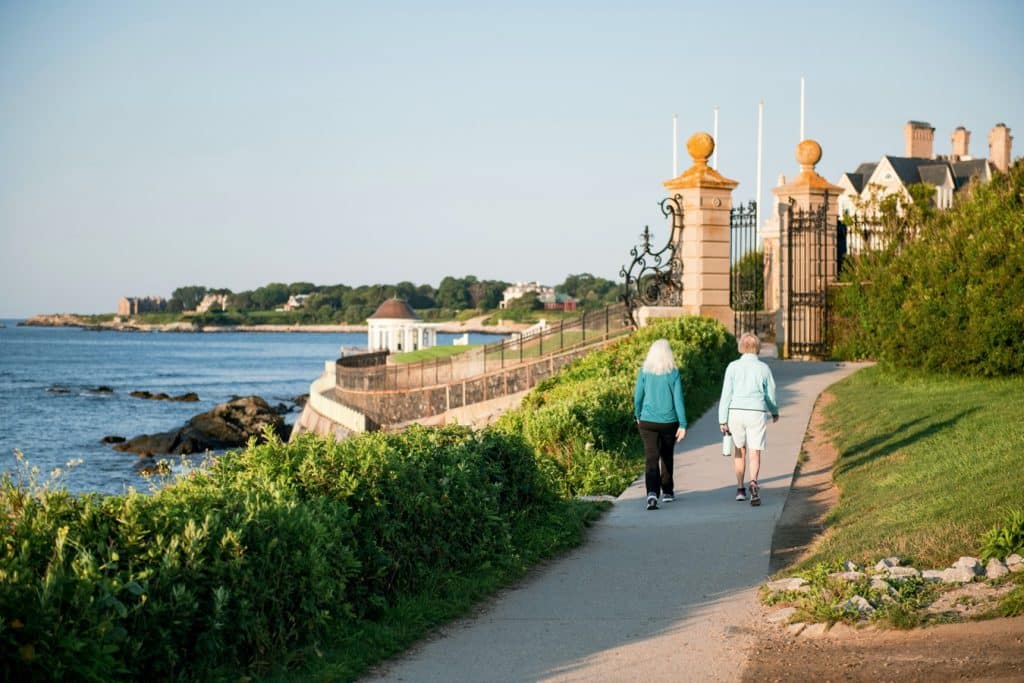The Newport Cliff Walk in Newport, Rhode Island
The famous Newport Cliff Walk brings you to the edge of the sea with Gilded Age mansions as a backdrop.

Winding between opulent homes and the ocean, the Newport Cliff Walk offers the same views that wealthy 19th-century homeowners paid a pretty penny to secure for themselves.
Photo Credit : Cate Brownby Kevin Koczwara
An old man sat on a bench and strummed a guitar, his case open in front of him for tips. A young boy’s mother coaxed him to go over to the man to get his picture taken. The man kept singing, kept strumming. Some of the crowd at the top of the 40 Steps, a landmark on the Cliff Walk in Newport, Rhode Island, walked past, their journey along this part of the 3½-mile path nearly finished as an exit point beckoned nearby. Parents held their children in the warm rays of summer. The little boy finally got close enough. The man turned his head to look at him as he sang. The child’s mother took the picture and laughed.
My wife and I were just beginning our walk when we sat next to the man and his guitar. I had miscalculated our directions and missed the start of the Cliff Walk. We found our way to the 40 Steps, which once led right down to the water, and walked down the steps onto the rocks at the end. Families congregated there, and selfie sticks came out for pictures. We ate our packed lunches while watching the waves lapping against the rocks. The steps make a natural end point for many people, a safe place to leave the walk before the footing turns dicey. After the 40 Steps, the lavish 19th-century mansion known as The Breakers is the next spot to leave before the Cliff Walk transforms from a leisurely stroll with a few challenging moments into more of a rock-climbing adventure.
The cliffs of Newport differ from other famous cliffs, though, like those of Dover or Moher. They don’t feel like the ends of the earth the way the others do. The Cliff Walk inspires a different kind of infatuation and sense of awe. It offers the ability to peer into the American dream of wealth and power—of owning a home so large that it could live only on a cliff’s edge.
Founded in 1639, Newport began its transformation into a vacation spot for the well-to-do in the 1800s. The wealthiest families from Boston, New York City, and Baltimore started building their summer “cottages” here in the 1850s. When the Gilded Age arrived, Newport became where the one-percenters built their second homes, secluding themselves from the busy beaches filled with the workers who lived closer to the factories.
As it took shape in the 1880s, the Cliff Walk—a public right-of-way over private property, including some of Newport’s oldest and grandest estates—gave people whose view of the ocean had been blocked by the mansions not only access to vistas of crashing waves, but also a way to peek into a hidden world.

Photo Credit : Cate Brown
Storms have taken their toll on the Cliff Walk, though. For more than a year there’s been a detour off Narragansett Avenue due to damage—and not for the first time. Hurricane Sandy in 2012 caused closures and cost some $5.2 million in repairs. Before that, the path needed rebuilding after the Hurricane of ’38 washed much of it away. The path now has more railings and a more family-friendly vibe to it, thanks to the improvements.
As we walked, the concrete path became a jetty for a time, and then just a direction along some large rocks. When we reached The Breakers, my wife climbed down
the side of the wall and onto the rocks below. She explored the pools. Waves crashed nearby. While the crowd above bustled past, we felt the ocean spray, the thing that brought vacationers to Newport in the first place.
We ventured farther along the trail and became more and more alone. The wind picked up and cooled us from the more strenuous climbs. The rocks became more interesting, more open and accessible. There were pools with algae and seaweed. As the landscape opened, we also saw more “Private Property” signs; the homes somehow felt bigger, and bolder, the farther we got from downtown.
Near the finale of our walk, the path lost its ocean view as vegetation on both sides connected, making it feel like a secret passage in a children’s story. We came out near a beach with only a few people on it. A sign read “Private.” We had arrived at Bailey’s Beach, a private beach club founded in the 1890s to give the elite some distance from the working class at nearby Easton’s Beach. When the wealthy families built homes along the cliff, they were deeded passes.
Next to Bailey’s Beach there’s a small patch of sand called Rejects Beach. We walked onto it and took off our shoes. We dipped our feet into the ocean. The water, clear and blue, felt warmer than expected. We could see over to the private beach. We could dream, just as we can dream of living in the homes along the walk. It’s that perception that feeds us. We can’t have the homes, we won’t ever belong to the Bailey’s Beach club, but for generations the Cliff Walk, the easy and the hard, has been here for old men with guitars, young families, joggers, couples holding hands. Even as property owners at times have tried to put up obstacles, walkers continue striding by, inhaling the sea scent, listening to waves on rocks, a sound we hear better than anyone inside their palaces.


